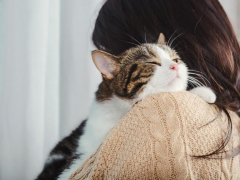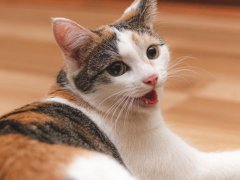
Cat at the vet getting ready for a neutering procedure. Prostock-studio / Shutterstock.com
Deciding whether to spay or neuter your cat can evoke mixed emotions. It’s natural to feel excited about your kitten’s future, concerned about the cat’s recovery post-surgery, and curious about potential changes in their behavior.
This article will explore how spaying and neutering can influence cat behavior to help you decide whether to have your cat sterilized or keep them intact.
Why Should You Spay or Neuter a Cat?
Spaying (for females) and neutering (for males) are essential surgical procedures for responsible pet ownership. Most veterinarians recommend sterilizing cats at around 5 months, as they can reach sexual maturity as early as 4 months. However, large breed cats, such as Maine Coons, can be sterilized between 6 to 9 months due to their slower growth and maturity, as they typically reach their full size between 3 to 5 years old.
Spaying and neutering contribute significantly to your cat’s health and well-being. It helps prevent reproductive emergencies and lowers the risk of mammary cancer in females and testicular cancer in males. Additionally, spaying reduces the likelihood of pyometra (womb infections) in female cats.
Unneutered male cats tend to roam and fight more often, which increases their risk of exposure to contracting feline immunodeficiency virus (FIV) and feline leukemia virus (FeLV). By neutering your male cat, you decrease his likelihood of contracting these viruses, protecting his health.
Spaying and neutering can help reduce specific behavioral issues, minimize shelter relinquishment, and decrease the overpopulation of cats in the community. Moreover, studies have shown that spayed cats live 39% longer than intact female cats, and neutered cats live 62% longer than intact males.
Male and Female Cat Behavior Before Neutering
A cat’s social behavior is associated with finding a mate, reproducing, and rearing young.
Unneutered male cats with access to the outdoors will likely venture extensively out of their territory, actively defend their area, including resources, and fight to compete for a female. Indoor intact male cats might urine spray, display mounting behavior, and be aggressive to their owners.
Unspayed female cats can go into heat as early as 6 months, although this may happen earlier or later depending on the individual cat. During their sexually active times, they might loudly call for a mate, roll around on the floor, and constantly rub against your legs or furniture. Unspayed female cats can attract unneutered males, leading to issues such as spraying, fighting, and loud vocalizations in the vicinity.
A female cat in heat might try to leave the house to find a mate, putting her at risk of getting lost. Indoor unspayed females might also spray to attract males and exhibit aggressive behavior, such as being irritable toward their owners and pacing around doors.
Male Cat Behavior After Neutering

Neutered male cats tend to stay close to home rather than roaming to find mates. Magui RF / Shutterstock.com
Cat neutering involves surgically removing a male cat’s testicles, which results in various behavioral changes. Let’s examine the procedure’s effects on male behavior and the benefits it offers.
Decreases the Need To Look for a Mate
Castration reduces the need to look for a mate due to the decrease in cortisol (a stress hormone) and reduced production of sex hormones, such as testosterone. This can lead to diminished sexual behavior and mating instincts in a tomcat.
Reduces Roaming Behavior
Sterilized male cats exhibit reduced roaming behavior compared to unsterilized males. This is because, without the desire to mate, they are less likely to actively seek out females for mating.
Curtails Territorial Fights and Inter-Cat Aggression
Intact males actively defend their territory from competing males to prevent reproductive access to females. Once neutered, males are less likely to protect their territory with hostile behaviors toward intruders or get into fights with other male cats.
Neutering male cats diminishes aggression toward other males. Overt aggression is avoided where possible, as the risk of injury is high. Instead, cats tend to navigate around each other to avoid confrontation. If a male cat lives with another cat he doesn’t get along with, he might increase his territory within the home to avoid sharing the same space at the same time with the other cat. However, fights can still happen if the male cat is stressed, fearful or in pain.
Various studies of free-roaming colonies in Israel concluded that trap-neuter-return (TNR) programs reduced aggressiveness and vocalizations among free-ranging males toward males straying into the territory area.
Reduces Frustration
Neutering intact males can reduce frustration-related behaviors, such as pacing, humping, and scratching at the door wanting to be let out constantly.
Lowers Urine Spraying Behaviors
Both male and female cats can spray urine, but unsterilized males tend to do it more often. Unneutered male cats mark their territory with urine to show they are ready to mate. After being neutered, about 90% of male cats show a decrease in spraying behavior.
Another benefit is the reduction of intense male urine odor. Sterilization changes the urine odor, generally making it less strong-smelling.
Reduces Redirected Aggression to Humans
Neutering a male cat can reduce his aggressive behavior toward humans. However, there is no guarantee that a neutered male cat won’t bite or redirect aggression toward his owner, especially if he has been encouraged to play-bite or engage in roughhousing as a kitten. Teaching appropriate kitten behavior during adolescence is essential to avoid such issues.
Female Cat Behavior After Spaying

Spayed female cats tend to be more relaxed and bonded with their human companions. RJ22 / Shutterstock.com
Cat spaying involves surgical removal of a female’s ovaries and uterus, which results in many behavioral changes. Let’s explore the influence of cat spay on female behavior.
Eliminates Heat Cycles and Ensures a More Relaxed Cat
The most significant effect of spaying is the suppression of heat cycles and the need to reproduce. Without hormonal fluctuations and heat cycles lasting two to three weeks, a spayed female is usually more relaxed and content at home because her breeding instinct is reduced. It’s vital to note that it might take some time for a cat’s hormones to balance out and for the full effects of spaying to be seen.
Minimizes Wandering and Getting Lost
Desexing female cats reduces their urge to wander off your property looking for a mate and not return home. They are also less likely to get injured, fight with another cat, or be killed in road traffic accidents.
Decreases Irritable Behavior
Spayed females won’t come into season roughly every three weeks during sexually active times, which decreases irritable behaviors during estrus, such as loud calling, restlessness, anxiety, and territorial behavior. This is a comfort for many owners wanting a peaceful home.
Diminishes Undesirable Urine Marking
De-sexing diminishes urine marking in female cats by 95% by removing hormonal influences. It’s important to note that urine marking is directly linked to the proportion of cats within a household. While spaying does change the frequency of urine-marking behavior in cats, it does not prevent the behavior in all cats.
Less Aggressive Defense of Territory and Feeding-Related Aggression
A study conducted on eight feeding groups in an urban area of Israel found that females, when removed from the group, spayed and then returned, showed reduced aggression. This included less aggressive defense of territory against males and females not part of the group and reduced feeding-related aggression toward other group members.
Prevents Maternal Aggression
Pregnant cats and those showing phantom pregnancy might display aggressive behavior toward their owners near the end of their pregnancy. Similarly, cats that have given birth might react aggressively when the litter is approached by the owner. This aggressive behavior can continue during lactation and whenever the kittens are present. Spaying a female cat prevents this type of maternal aggression.
Enhances Socialization
Altered cats not focused on territory defense are much more relaxed and receptive to bonding with humans and other cats within the household, leading to better and more harmonious lives in multi-cat households and with their human companions.
Moderates Hunting Behavior
Although cats are prolific hunters, sterilized indoor-outdoor females might hunt fewer birds and other animals since they won’t need to feed their kittens, which can help protect wildlife.
Frequently Asked Questions
Do female cats get calmer after spaying?
Yes, female cats generally become calmer after being spayed. This is because spaying reduces the levels of hormones that can contribute to territorial behavior and aggressiveness. Additionally, spaying eliminates the stress and discomfort associated with the heat cycle. It's important to remember that individual cats might respond differently; however, spaying generally mellows out a female cat.
Do male cats get friendlier after neutering?
When male cats are neutered, they often become friendlier and more sociable. Neutering can reduce undesirable behaviors, such as roaming, fighting, territorial marking, and aggression, making male cats more affectionate and social with their owners. It's important to note that there can be exceptions to this general rule, as individual cats might still exhibit territorial marking and aggression behaviors to varying degrees.
Do cats become clingy after being spayed?
Every cat is unique, so their behavior after being spayed might vary. Some cats might become clingier due to hormonal changes, anxiety or stress, or discomfort from the vet visit and surgical procedure. However, spaying generally doesn't change your cat's personality or make them clingier. It's best to observe your cat's behavior and consult a veterinarian if you notice any changes.
-
United Spay Alliance. (2024, January 18). Feline Fix by Five - United Spay Alliance.
-
Care, I. C. (2020, September 1). Advanced Feline Behaviour for Vet Professionals. Module 2: Senses and communication. UK.
-
Care, I. C. (2020, September 01). Advanced Feline Behaviour for Vet Professionals .Module 1: What am I and where did I come from. UK.
-
F Horwitz, D. (2019). Common Feline Problem Behaviors: Urine spraying. Journal of Feline Medicine and Surgery, 21, 209–219.
-
Amat, M., & Manteca, X. (2019). Common feline problem behaviours: Owner-directed aggression. Journal of Feline Medicine and Surgery, 21(3), 245–255.
-
Scource, B. (2019, October 7). Neutering your cat. International Cat Care.
-
Cafazzo, S., Bonanni, R., & Natoli, E. (2019). Neutering effects on social behaviour of urban unowned free-roaming domestic cats. Animals, 9(12), 1105.
-
Ferreira, G. A., Machado, J. C., Nakano-Oliveira, E., Andriolo, A., & Genaro, G. (2020). The effect of castration on home range size and activity patterns of domestic cats living in a natural area in a protected area on a Brazilian island. Applied Animal Behaviour Science, 230, 105049.







